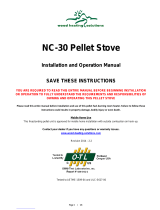
WARNINGS AND RECOMMENDATIONS
A. Do not abuse the glass by striking or slamming the door shut.
B. Do not attempt to operate the stove with broken glass.
C. Do not attempt to open the door and clean the glass while the unit is in operation. If you must
clean the glass, use a soft cotton cloth and mild window cleaner.
D. Do not use abrasive cleaners to clean the surface or any part of the stove.
E. It is recommended that the unit be secured into its position in order to avoid any displacement.
F. Never use gasoline, gasoline-type lantern fuel, kerosene, or similar liquids to start the fire. Keep
all such liquids well away from the pellet stove while it is in use.
G. Disposal of ashes - Ashes should be placed in a metal container with a tight fitting lid. The
closed container of ashes should be on a non-combustible floor or on the ground, well away
from all combustible materials pending final disposal. If the ashes are disposed of by burial in
soil or otherwise locally dispersed, they should be retained in the closed container until all
cinders have thoroughly cooled.
H. Make sure the ash pan is closed tightly during the operation of the stove.
I. Fresh air intake is strongly recommended. Failure to install Intake air may result in improper
combustion as well as the unit the unit smoking during power failures.
NOTE: Fresh air is mandatory on all units installed in “Mobile Homes” as well as “Air Tight”
homes.
J. GOLD BARS: Clean all fingerprints off of all the gold parts before firing each time. Fingerprints
etc. can become etched in the gold if not removed before operating the pellet heater.
K. BRICK PANEL: The paint on the steel brick panel may peel, this is due to the extreme
conditions applied to the paint and is in no way covered under warranty.
L. KEEP ASH PAN FREE OF RAW FUEL. DO NOT PLACE UNBURNED OR NEW PELLET
FUEL IN ASH PAN. A fire in the ash pan could be the result.
AUTOMATIC SAFETY FEATURES OF YOUR PELLET STOVE
A. With the auto/manual switch in the auto position, the stove will shut off when the fire goes out
and the exhaust temperature drops below 120° F (49°C). If the switch is in the manual position,
the stove will continue to feed pellets into the burn pot after the exhaust temperature drops
below 120° F (49°C) and the ignitor will reheat.
B. The stove has a high temperature safety switch. If the temperature at the back of the firebox
reaches 200° F (93°C), the auger will automatically stop, and the stove will shut down when the
exhaust temperature cools. If this happens, call your local dealer to reset the 200° F (93°C)
high limit switch. ALSO FIND THE REASONS WHY THE UNIT OVERHEATED.
C. The stove has a convection fan control over-ride. This function causes the convection fan to
reach its full speed when the temperature at the back of the firebox reaches 160° F (71°C). This
is a normal safety feature of your unit. To compensate for the fan cycling action that may occur,
turn up the blower control proportionately to the heat output.
If the power goes out, the stove will stop running. When the power comes back on, the stove
will not restart if the switch is in the auto position and the exhaust temperature is below 120° F
(49°C). If the exhaust temperature is above 120° F (49°C) or the switch is in the manual position,
the stove will start to feed pellets again and may re-light itself
5





















